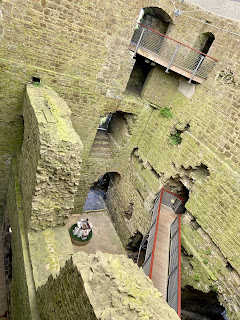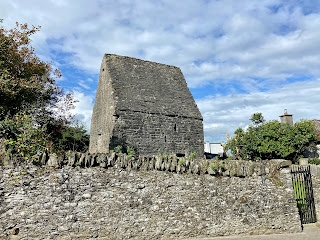Our friends invite us to stay the weekend in County Meath and tour the local sites. On Saturday, we're in Balbriggan (County Fingal, pop 21,722 in 2016), a commuter town on the DART, with a striking Martello Tower (nineteenth century).
To the north of the Tower, Bremore Castle stands above a beautifully eroded seacoast, the lush shoal, and the Irish Sea. To the south, a compact beacon stands on a jetty, which encloses the local beach. Further out are Skerries and the small islands just off Ireland's shore, trailing into the horizon.
Near the site, we meet Anthony Murphy, a local journalist and 'amateur archeologist' (well-known discoverer of 'Dronehenge' in 2018). He has the key and is waiting for a tour group. There is a stone stile, and a dirt path that leads up to the ridge; we can see the bright-green bump suspended in the tall, dry grass.
Anthony unlocks the sheet-steel door and swings it open. The threshold is flooded by the recent rains, so it's an awkward hop-jump into the passage, but everyone makes it.
We are off now to Trim Castle (twelfth century), protecting the River Boyne. The Castle is an important chapter in the history of British power in Ireland – built by Hugh de Lacy, Lord of Meath. More recently, it is famous as a filming site for Braveheart (all those Scottish warriors? Irish extras). Though the riverbanks are currently overgrown (compared to the website), our patrol of the grounds offers fairy-tale views – we are ready to rush the gate and shout, "Freedom!".
Inside the passage tomb (top image), there is no artificial lighting, but holes pierce the (modern concrete) cap that allows targeted shafts to illuminate the key features. The passage opens to an unexpectedly wide, egg-shaped chamber. The walls are built of large, raw stones, with smaller shaped rocks laid in horizontal courses.
Straight ahead is a tight niche with a sill-stone and a decorated lintel. On our left is another undecorated niche, and on our right is a larger one with an even more elaborate lintel – ten lozenges versus four. Anthony tells us the right-hand position appears to be the place of honor in these types of tombs.
Just in front of this recess is another carved lintel stone, standing on-end, but which may have been over the main entrance (eight lozenges); the 'underside' is embellished with circular patterns. The artwork is the result of 'picking' with a harder stone. The state of preservation is astonishing, the pick marks look so fresh.
Opposite this lintel, on the shelf above and to the side of the lesser recess, is another carved stone with designs on two faces, though it currently sits face down to protect the art (Anthony's hand gesture below). The designs here and on a few other stones are much rougher (incomplete?), suggesting they may be the result of 'practice'.
Just below that is a stone known as the guardian stone for its a diamond-shaped eye, sharp nose, and smiling mouth. And on either side of the entrance passage are two more carved pieces. Turning now to face the doorway, on the left (honored side), is a stone with beautifully chiseled chevrons; Anthony believes this is the inner passage lintel. On the right are conspicuous circular designs that might also represents guardian eyes, keeping watch.
As with other megalithic sites, we wonder about solar alignments (as we saw in Évora). Anthony tells us that Newgrange, the tomb at Brú na Bóinne, aligns to Fourknocks. He has a theory that Fourknocks has a stellar alignment to Deneb, the bright star of the constellation Cygnus. Using the inset pavers to climb to the top, we can look south and north.
Oh, those clouds don't look good. The mound really is connected to the heavens. We hurry back to the cars.
On Sunday, we grab breakfast in Naul (County Fingal, pop 568 in 2016), or as the locals say, 'The Naul'. We park near a memorial to Séamus Ennis, a well-known local musician who passed in 1982. The shopkeeper where we get our coffee tells us he was a bit of a rough character.
Perhaps he is interred in the local cemetery. We do not make an exhaustive search, and do not find him, but the ruined chapel and the time-worn graves make a contemplative start to the day. Several of the headstones are askew; the gable ends are not quite square. The gorgeous, rectilinear dedication appears to be dated 1710. The sum effect is time-worn and personal.
Each site tells its own story: the carved stone book with dried-rose bookmark dedicated to "Sister", William and Mary Daughton who joined their son (died in 1893 at age 18), the precious collection of female figurines, and the hand-painted sign (placed at another's grave?) that reads: "Pray for the soul of Catherine Brady died 15-1-1961".
While the Keep appears to be generally intact, the outer structures are in various states of ruin. Along the Boyne are the older, twelfth century curtain walls and the River Gate. To the west is the Trim Gate, with its enclosed approach road.
Once inside the walls, we see that the Keep is located behind a defensive ditch with remnants of other structures at its base. And from the timber pockets and rough masonry we can see that the Keep is also what remains of a larger building. The twisting rocks and shaped lawn add energy and character; the midday sun adds dramatic contrast to the Tower's textures and openings.
A recently added stairway rises to the elevated door, and we begin the tour. It's a relief that the added stairs and bridges make no attempt to blend with the castle – these are added pieces (unlike, say, at the Castle in Guimarães). The hearty central yard and chunky corner towers are topped with a translucent fabric cover; there is still moss on the walls, but this is not a scramble over damp or uneven floors.
The tensile roof provides plenty of diffuse light and allows the museum staff to show a series of models that illustrate the growth of the walls upward and outward: 'Trim Castle thorough the ages'. The broken edges of the openings, the random overhangs in the corners, and the cascading light blend to make a compelling presentation.
But despite some of the modern interventions, we must still climb the old spiral stairs.
The tour arrives at a small Chapel, distinguished primarily by the twin-alcove with basins formed in the sill for holy water. There are lines in the stonework where a roof existed, as well as other slots and edges where the construction changed.
The catwalks go up and turn through another broken opening, and across to the opposite corner. The enthralling views from the catwalks get better as we ascend.
From the top, the views are tremendous: the Trim Gate to the west, the river-side fortifications, the River Boyne curving to the southeast, the round Barbican Tower to the east, and the spire of St Patrick's Church (Catholic, nineteenth century) to the south.
We land on the ground on the south side of the central yard, which is divided by another thick wall. The guide tells us this is the 'family side' of the with its epic fireplace. The flue is a corkscrew, and we can see for ourselves.
We take a few more minutes to inspect the outer defenses.
Before heading home, we stop in the village of Kells (pop 6,135 in 2016), the former home of the famous illuminated manuscript. After a quick lunch in town, we head up the hill to St Columba's House (tenth century). This incredible stone house, with the tiniest windows, looks completely out of place and time. Even the protective wall seems other-worldly next to the small residential cottages.
Around the corner is the Abbey of Kells (sixth to ninth centuries), with St Columba's Church (eighteenth century), Bell Tower (twelfth century), and the Kells Round Tower (tenth century). Along with the House, it's a remarkable architectural collection.
There are several famous High Crosses and other monuments in the cemetery, including the East Cross ('unfinished', no top), the Sundial, and the East Cross (tenth century, in the Tower's shadow, damaged by Cromwell's soldiers). So many of the images are still sharp: the large figure on the East Cross, the lines of the sundial, and the pair of figures with the tree on the West Cross.
We consider the scope of history saved in these stones and all-around County Meath: the megalithic people, the earliest Christians, the British occupiers, and the musician who died forty years ago.
The Bell Tower anchors the north side of the cemetery. The base is covered with more wonderful, worn carvings. Weeds spill from the lancets and dot the block courses. The Tower's square base is all that's left of the old medieval church; the neighboring church and the Tower's spire date from the eighteenth century, as the tablet above the door testifies:
This Spire was Erected
Anno 1783
at the Entire Expence of
It was designed by Tho Cooley
Esq and was Executed by
M Iohn Walsh Stone Cutter



































































































No comments:
Post a Comment